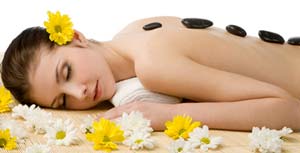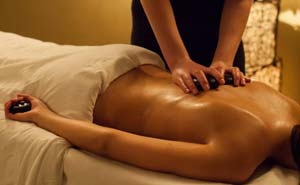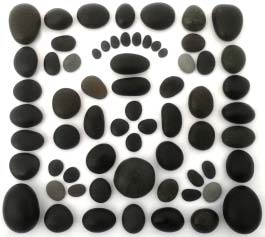The stones are heated to 130-135F, and used to a client’s maximum comfort level (never too hot). They come in many shapes and sizes, conforming to the body’s natural curves and muscle shapes. Here’s how they work.
 looks great, but not “massage” |
 that’s more like it |
Google “hot stone massage” and you’ll see people lying peacefully on a bed of flowers with stones artfully arranged across their body. This feels great for a few minutes, but those small rocks cool quickly and there’s not much real physical therapy taking place. The best benefit comes from using larger stones that retain their heat, using a bit of extra oil to give them a pleasant glide, and drawing them along tight muscles. Like soaking in a hot tub, or like applying Bengay or Tiger Balm heat rub, warmth helps muscles loosen, breathing slow, and the mind come to ease. The heat combined with the glide causes the mind to just “let go” of its held tension. It turns a relaxation massage into a very-relaxed one!
But the real magic comes when the stones are combined with therapeutic work, like deep-tissue or myofascial. The collagen fibers which form most of our body’s structure, from the smallest cellular matrix to the longest tendon, respond to heat by getting longer and more flexible. The dense stone can then be used as a tool to quickly soften hard knots, loosen tight parts, relieve joint arthritis, and improve range-of-motion. Using only a small amount of lotion for fascial work, the smooth rock can grip and stretch the tissues while softening them at the same time, in a way that hands simply can’t.
This also means the stones can treat injuries or chronic tightness which regular manual therapy can’t: stiffness in the body is only released after it’s “warmed-up,” which regular massage does with repetitive strokes, gradually working deeper one layer at a time, until the sore levels are reached. Warming-up the tissues this way can take a while, particularly for someone with chronic pain, old childhood injuries, or physical trauma like whiplash. But add some heat, especially if it feels pleasurable like the energetic stones do, and the warm-up goes much quicker. Combine that with a dense rounded tool and some pressure, and you have all the ingredients for fast relief.
 the magic tools, from Ocean Stone. The ones I use are much larger. |
I’m lucky to have a somewhat rare set of stones called Andesite (see Wikipedia), hand-picked by massage students along the Pacific coast. They are unusually heavy, quite smooth, and full of barely-visible tiny crystals embedded in lustrous black.
Andesite is a form of basalt. Named after the Andes, this stone is found around the Pacific Ring of Fire where the volcanoes meet the coast. Most minerals we encounter when we dig in the garden, like granite, were formed through gradual cooling which results in coarse-grained lightweight material. But basalts occur when hot dense magma breaks through the surface of the earth and quickly chills, like when a volcano upwells under an ocean. This can produce a rock with very fine grains, a soft-feeling surface, and infused with thousands of tiny crystals. Interestingly, andesite is also found in meteorites and is a major component of the Martian crust, so these stones are truly “from the heavens”!
Because this kind of andesite is often produced where magma meets water, it can be uncommon to find it on land (at least in BC). After tumbling along the ocean floor for eons, slowly becoming smooth as silk, these rocks came to the shore — where they were collected by sharp-eyed students of Ocean Stone Therapy on their trips to the beaches of Vancouver Island. Most hot-stone sets tend to be regular basalt, granite, or marble, all of which are less dense (and lighter in colour). The weight of the stones make a big difference in how long they retain their warmth. Andesite is so dense that it has a magical property: it reheats itself! After the surface of the stone has cooled, energy continues to radiate from the core which re-heats the outside.
